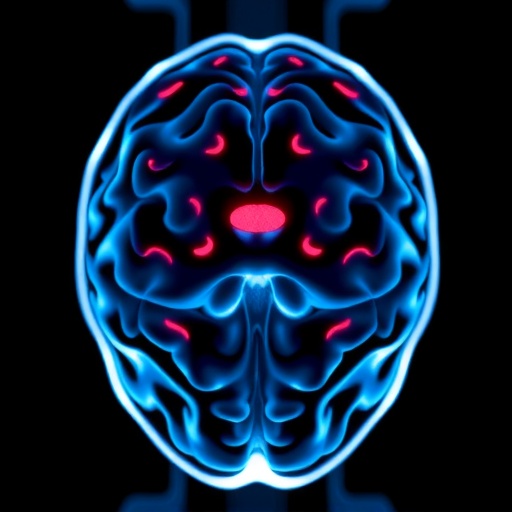In recent years, the prevalence of depression among university students worldwide has surged dramatically, signaling an urgent call for innovative and effective treatment strategies. Despite the availability of various therapeutic interventions, only a fraction of individuals with depression—approximately one-third—experience a full remission of symptoms. This persistent treatment gap underscores the necessity for precision medicine approaches that tailor interventions to individual neurobiological profiles. Among emerging modalities, high-definition transcranial direct current stimulation (HD-tDCS) has garnered significant interest due to its potential to modulate neural circuits implicated in depressive disorders. However, the optimal parameters for HD-tDCS and the underlying mechanisms driving its antidepressant effects remain largely uncharted.
A novel research initiative seeks to fill this knowledge gap by exploring the efficacy and biological mechanisms of magnetic resonance imaging (MRI)-guided HD-tDCS in alleviating depression among university students. This approach leverages advanced neuroimaging to precisely target brain regions, addressing individual anatomical variability that often hampers the effectiveness of non-invasive brain stimulation techniques. By integrating MRI data to customize electrode placement, researchers aim to optimize stimulation delivered to the left dorsolateral prefrontal cortex (DLPFC), a critical hub in mood regulation and cognitive control.
The study employs a stepped wedge cluster randomized controlled trial design—a robust methodology that allows for staggered implementation of the intervention across participant groups while maintaining randomization to control for time-dependent confounds. Participants are randomized into four clusters, all initially undergoing a sham or placebo stimulation phase during the first week. Subsequently, each week, one group transitions to active HD-tDCS intervention until, by the fifth week, all groups receive the active treatment. This design not only facilitates ethical distribution of the intervention to all participants but also enhances statistical power by leveraging within-subject comparisons over time.
Central to the intervention is the precise positioning of the central anodal electrode over the left DLPFC. Surrounding this are four return electrodes, strategically placed 3.5 centimeters from the anode, creating a circular current loop intended to focus electrical current flow and enhance the specificity of cortical modulation. Stimulation parameters are standardized at 2 milliamperes (mA) delivered for 30 minutes per day, five days per week, reflecting safety guidelines and prior empirical evidence suggesting efficacy at this dosage.
Beyond clinical symptom evaluation, the trial incorporates comprehensive neuropsychological assessments at baseline, weekly during intervention, and at a follow-up point approximately one month post-intervention. These assessments include the Hamilton Rating Scale for Depression (HAMD) and the Patient Health Questionnaire-9 (PHQ-9) as primary outcomes. Secondary measures probe additional dimensions commonly comorbid with depression, such as anxiety severity, insomnia, and stress levels, providing a nuanced understanding of HD-tDCS effects on the broader spectrum of mental health.
A distinguishing feature of this research is its multimodal neuroimaging component. Structural MRI scans are utilized not only for electrode montage optimization but also to examine potential neuroanatomical predictors or correlates of treatment response. Functional near-infrared spectroscopy (fNIRS) and repeated MRI sessions before and after the stimulation course are employed to investigate functional and hemodynamic changes in the brain. This blend of imaging modalities aims to elucidate the neural pathways and network dynamics modulated by HD-tDCS, contributing mechanistic insight that could drive future refinements in non-invasive brain stimulation.
The significance of MRI-guided HD-tDCS lies in its promise to transcend current, one-size-fits-all approaches to depression treatment. By tailoring intervention based on individual brain anatomy and monitoring neurofunctional responses in real time, this paradigm paves the way for truly personalized psychiatry. University students represent a critical target population for such innovations, as they are particularly susceptible to developing depression amid academic pressures and life transitions.
Moreover, the study’s longitudinal design, with multiple assessment points and follow-up, provides a rich dataset for evaluating not only immediate therapeutic effects but also sustainability and potential delayed benefits of HD-tDCS. Understanding temporal dynamics of symptom change and neural plasticity is paramount to establishing treatment guidelines and optimizing stimulation parameters for maximal clinical benefit.
As non-invasive brain stimulation techniques evolve, safety and tolerability remain paramount concerns. The protocol adheres to established safety standards and incorporates rigorous monitoring to identify any adverse effects or discomfort associated with HD-tDCS. This attention to participant well-being enhances the translational potential of the findings, supporting eventual integration into clinical practice.
The multi-disciplinary collaboration underpinning this research melds expertise in psychiatry, neuroimaging, bioengineering, and clinical trial methodology. Such integrative approaches are vital for unraveling the complex biopsychosocial facets of depression and harnessing cutting-edge technologies to improve mental health outcomes.
Anticipated recruitment for the trial is slated to begin in March 2025, with registration details openly accessible to ensure transparency and reproducibility. The trial’s outcomes are eagerly awaited by the psychiatric research community, as positive results could herald a paradigm shift in treating depression, especially among young adults navigating the challenges of university life.
In conclusion, this pioneering study stands at the frontier of precision psychiatry. By combining MRI-guided targeting with high-definition electrical stimulation and robust clinical evaluation, it aims to chart new pathways in understanding and treating depression. The findings have the potential not only to enhance therapeutic efficacy but also to illuminate fundamental brain-behavior relationships underlying mood disorders. This innovative trial epitomizes the future of personalized mental healthcare, promising hope for millions of students and beyond who grapple with the burden of depression.
Subject of Research: MRI-guided high-definition transcranial direct current stimulation (HD-tDCS) as an intervention for depression among university students, exploring therapeutic efficacy and underlying neural mechanisms.
Article Title: Efficacy and mechanisms underlying MRI-guided high-definition transcranial direct current stimulation for depression among university students: study protocol for a stepped wedge cluster randomized controlled trial
Article References:
Chen, Y., Liu, R., Yan, J. et al. Efficacy and mechanisms underlying MRI-guided high-definition transcranial direct current stimulation for depression among university students: study protocol for a stepped wedge cluster randomized controlled trial.
BMC Psychiatry 25, 630 (2025). https://doi.org/10.1186/s12888-025-07118-2
Image Credits: AI Generated
DOI: https://doi.org/10.1186/s12888-025-07118-2




